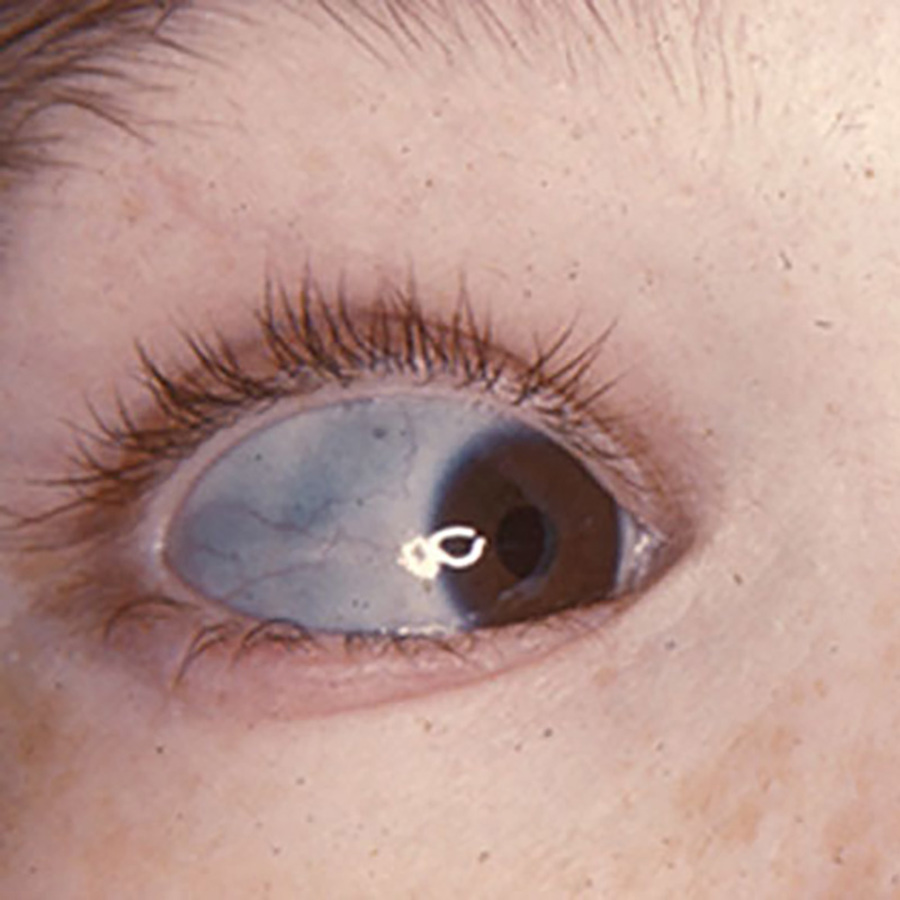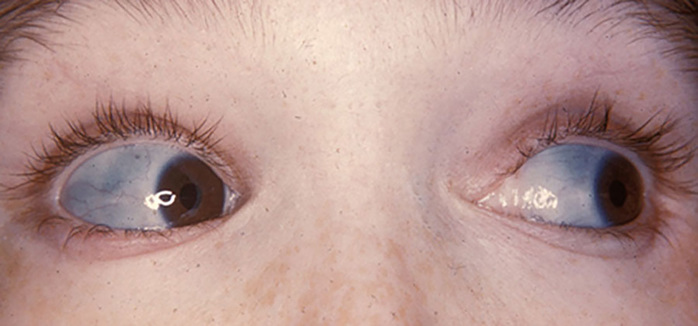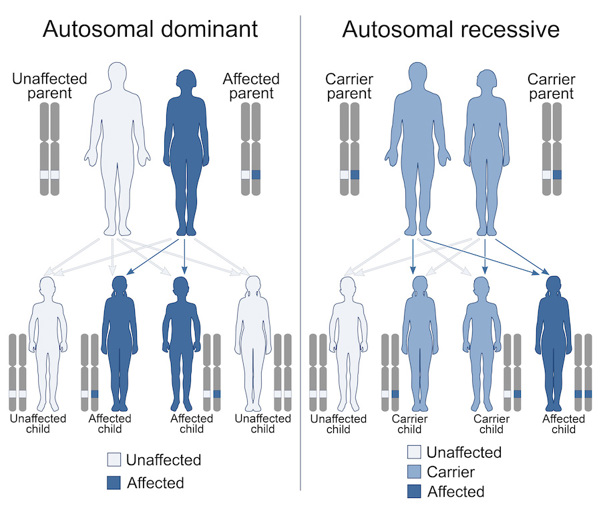
Why do the whites of my eyes have a bluish tint?
February 22, 2005

- Related Topics:
- Eye color,
- Autosomal dominant inheritance,
- Genetic conditions,
- Pleiotropy
A curious adult from Texas asks:
“The whites of my eyes have a bluish tint to them. I was told by my parents that marrying a woman with the same coloration would be bad for our children. They would be likely to have a brittle bone disease. Has any research been done on the cause of the blue whites?”
Blue scleras are very uncommon. You are truly a rare find!
The white of our eyes, also known as the sclera, serves as a protective outer coat. It is a tough, leather-like tissue that surrounds the entire eye.
The white sclera takes on a bluish tint when this normally thick tissue thins. The sclera becomes translucent, allowing the underlying tissue to show through.
There are lots of reasons someone can have blue "whites". Anything that results in a thinning of the sclera could cause it.
For example, some medications, like steroids, can produce blue sclera. Not having enough iron in your blood (anemia) and aging have also been shown to give a blue tint to the whites of the eye.
While most cases of sclera discoloration are benign, they can sometimes be a sign of something more serious like Osteogenesis Imperfecta, Ehlers-Danlos Syndrome, Russell Silver Syndrome, Pyknodysostosis, Hallermann- Schermann-Streiff syndrome and Marfan Syndrome.
It is important to note that all of these diseases are extremely rare and have other obvious symptoms as well. Anyone with a blue sclera may want to see an ophthalmologist to rule out these possibilities.

Blue sclera and Osteogenesis Imperfecta
As you indicated in your question, one extremely rare cause of blue sclera is Osteogenesis Imperfecta, or Brittle Bone Disease. Only 1 in of every 10,000 people has this rare disease.
As you may guess from its name, patients with Brittle Bone Disease have fragile bones that break easily. The condition is caused by problems with a crucial protein called collagen.
Collagen provides the internal scaffolding of our bodies, giving us shape and support. It can be likened to the iron beams that hold up a building. Faulty collagen leads to many problems for our body.
There are actually four types of Brittle Bone Disease whose symptoms range from mild to severe. Type I is the most common and, fortunately, the mildest. Not all patients have the same symptoms, but they usually have several of the most common. Blue sclera, easily fractured bones, curvature of the spine, brittle teeth, short height, and hearing loss are all frequently seen.
Types II, III, and IV are more severe than Type I and even less frequent. For instance, Type II is so severe, that these children die before or soon after birth.
Now, if I read your question correctly, your concern is that if someone's eyes have a bluish tint to them, then they may be a carrier for a disease like Brittle Bone Disease.
What is a carrier?
Remember, we have two copies of most of our approximately 25,000 genes, one from mom and one from dad. For a lot of diseases, you need two "bad" copies to end up with the disease, one from each parent. These are called recessive diseases.
A carrier is someone who has one "good" copy and one "bad" copy of a disease-related gene. They do not have the disease themself but could pass it along to their kids. This is what it means to be a carrier.
Other diseases only need one "bad" copy. This is the situation with most cases of Brittle Bone Disease. BBD is a dominant disease.
Brittle Bone Disease is caused by a mutation in one of the two genes that make that important collagen protein, Col1A1 or Col1A2. If someone has a single "bad" copy of either of these genes, they have the disease. Because of this, they also have a 50% chance of passing it down to their kids.
Where does the 50% number come from? Well, which of the two copies of a gene gets passed down to our kids is random. Since there are two copies, then there is a 1 in 2, or 50%, chance that the disease version will be passed on.
What if two people with BBD have kids? Then the chances of their children being affected goes up to 75%.
As you can see, diseases that need two "bad"copies of a gene (recessive diseases) can stay hidden in our gene pool through "carriers". This is not true of diseases caused by a single "bad" copy (dominant diseases).

Dominant diseases
You may wonder how the mutations for these rare dominant diseases stick around. Why aren't they purged over time? There are actually a couple good reasons.
With some diseases, symptoms don't appear until later in life. Individuals often pass along their "bad" gene to their children before they even know they have the disease themselves. Huntington's Disease is a classic example of this. Symptoms usually start cropping up between the ages of 30 and 45, sometimes even later. This is also true for some cases of Parkinson's, a disease we hear much of in the news due to the efforts of Michael J. Fox.
However, recent advancements are changing genetics. Genetic testing and pre-implantation embryo screening for some diseases can give people the choice not to pass on their "bad" genes.
Sometimes, mutations in our genes seemingly pop up out of nowhere. There is no family history of the disorder in these cases. This is called spontaneous mutation.
What happens is that the DNA gets changed in either the sperm or the egg and is passed onto the child. These changes can come from things in our environment or through mistakes our bodies make when it makes new DNA.
About 25% of children with Brittle Bone Disease can blame spontaneous mutations for their disorders.
It is important again to stress that anyone with blue sclera should see a doctor to rule out these rare diseases. Again, most cases of blue sclera are relatively harmless.

Author: Anne Tecklenburg Strehlow
When this answer was published in 2005, Anne was a Ph.D. candidate in the Department of Genetics, studying the genetics of Huntington disease in Rick Myers’s laboratory. Anne wrote this answer while participating in the Stanford at The Tech program.
 Skip Navigation
Skip Navigation
